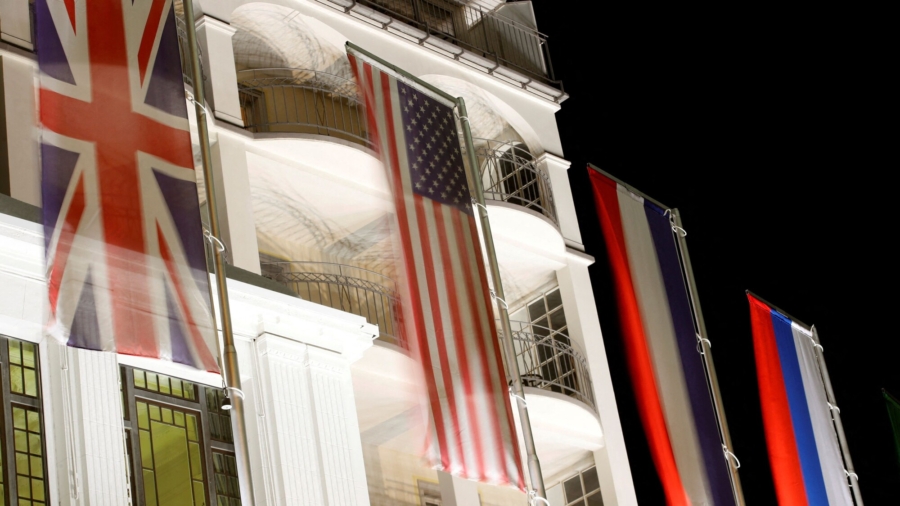News Analysis
Nuclear-armed China, France, Russia, the United Kingdom, and the United States—the five permanent members of the United Nations Security Council—released a joint statement on Jan. 3 stating their commitment to avoid an arms race and saying that they “consider the avoidance of war between Nuclear-Weapon States and the reduction of strategic risks as our foremost responsibilities.”
However, commentators have questioned whether the Chinese regime will truly honor the statement given Beijing’s poor track record at keeping its promises, and warn the world that the communist regime can’t be trusted.
“For the Chinese regime, this joint statement is just a piece of paper, and it won’t follow it,” Tang Jingyuan, U.S.-based China affairs commentator, told The Epoch Times on Jan. 3.
The joint statement was released on the first working day of 2022, and days after China only fulfilled 62 percent of its promise to phase one of the expired U.S.-China economic and trade agreement. China promised to purchase $200 billion more in U.S. goods and services in 2020 and 2021 above 2017 baseline levels in the agreement, which should have totaled $356.4 billion as of November 2021. In reality, China bought $221.9 billion, which is $134.5 billion less than agreed.
“The Chinese regime hasn’t even carried out its duty in a bilateral agreement. How can the world expect that it will fulfill its commitment in a joint statement?” Tang said. “The British should be more clear about this. The Chinese regime doesn’t respect the Joint Declaration on the Question of Hong Kong, in which it promised to maintain the city’s capitalism system for 50 years, and changed the former British colony into a communist city in just two decades.”
Tang warned further that Beijing might use this joint statement to lull the West into complacency, while progressing its aggressive targets in secret.
“Last July, the researchers at the Federation of American Scientists estimated that Beijing was constructing about 250 underground missile silos for nuclear missiles in western China, based on the satellite images,” Tang said.
“The U.S. Defense Department’s annual report in November estimated that China’s military could have 700 deliverable nuclear warheads by 2027 and 1,000 by 2030 … Now China has about 350 nuclear warheads. The Chinese regime is also improving hypersonic glide vehicles,” Tang added.
“If China really wants to be disarmament, why does it accelerate the production of nuclear warheads?” he said.
Economics professor specializing on Asia Antonio Graceffo also doesn’t believe the Chinese regime aims to fulfill its promise made in the joint statement.
“China often calls for nuclear disarmament of other countries, while they continue to build their own nuclear arsenal. It is a show, just like China calling for green energy and reduction of pollution, while China continues to pollute,” Graceffo told The Epoch Times on Jan. 3. “There is no enforcement, so it is easy for China to agree to anything.”

Joint Statement
On Jan. 3, all five states, including the White House, released the joint statement in their language.
“We affirm that a nuclear war cannot be won and must never be fought,” the English-language version read. “As nuclear use would have far-reaching consequences, we also affirm that nuclear weapons—for as long as they continue to exist—should serve defensive purposes, deter aggression, and prevent war.”
The statement emphasized that the five countries would work with all states “to create a security environment more conducive to progress on disarmament with the ultimate goal of a world without nuclear weapons with undiminished security for all.”
To reach the goal, the states said: “We reaffirm the importance of addressing nuclear threats and emphasize the importance of preserving and complying with our bilateral and multilateral non-proliferation, disarmament, and arms control agreements and commitments.”
According to the Federation of American Scientists (FAS), the United States has about 5,600 nuclear warheads, while Russia has 6,257 in their stockpile. Both of them share about 91 percent of the total nuclear warheads in the world.
Except the United States, Russia, UK, France, China, Pakistan, India, Israel, and North Korea also have nuclear warheads. The FAS also reported in October 2021 that Russia, UK, Pakistan, India, and North Korea also have plans to increase their nuclear warheads stockpiles, but the speed might not be as fast as the Chinese regime.

Since he took office on Jan. 20, 2020, U.S. President Joe Biden has outlined a U.S. plan for less reliance on nuclear weapons. However, the ambitions and actions of Russia and China may force the United States to reevaluate the situation carefully.
In recent weeks, Russia sent about 100,000 troops to the border regions near Ukraine, which has raised concerns about Russia’s intentions.
Biden and Russian President Vladimir Putin had a phone call on Dec. 30 to discuss the eastern Ukraine issue, and senior American and Russian officials are scheduled for follow up talks in Geneva on Jan. 9 to Jan. 10.
Meanwhile, the regime in Beijing is constantly sending warplanes into the Taiwan Air Defense Identification Zone, and warships to the East China Sea and South China Sea. The Chinese regime claims Taiwan as its own, despite the fact that the island is a de facto independent country, with its own military, democratically-elected government, and constitution.
From The Epoch Times


